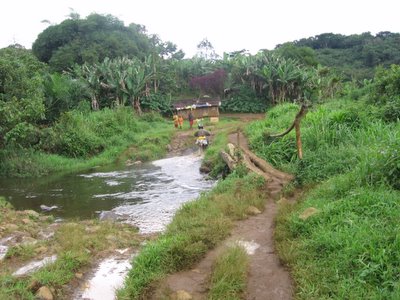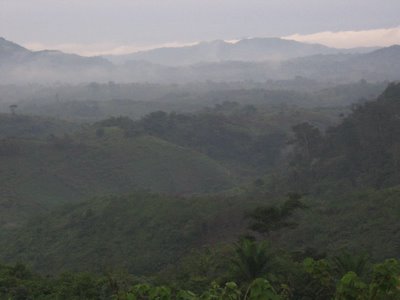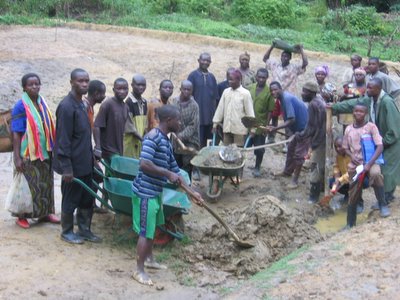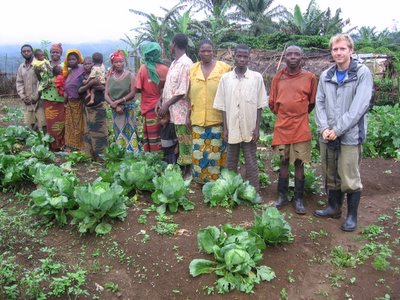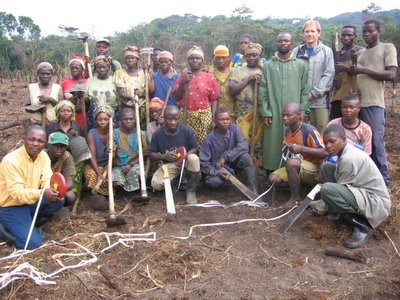February 3:
Today Jean-Marie, who’s the Food for the Hungry (FHI) agronomist based here in
Shabunda, took me to see FHI’s projects in Shabunda and its close environs. We started by going to the demonstration agricultural plots that are adjacent to a Center for Supplemental Feeding, and a Center for Therapeutic Feeding for malnourished children. This other NGO Action Contre la Faim runs the centers; and FHI offers agricultural trainings, and then seed/tool distributions for the mamas who are enrolled at the centers. The Supplemental feeding is more ‘outpatient.’ For the Therapeutic, though, the mamas and children stay at the centre for a max of 60 days while they try to get the child/children to decent health. Jean Marie toured me around the field where we have the plot, and then we took a tour of the centre itself. It was like one of those ads you see for starving children in Africa or something. All these way malnourished infants and toddlers lying on mats; mothers there too some lying down also. There were just rows of mats on the floor in a big room. Mosquito nets hung above the mats. I felt like I was in one of those ads in some ways too. Like the white person coming to say look at the starving African children, won’t you give 32 cents a day to save one or whatever. BUT the thing I think is really great is FHI’s role in it all. This provision of training to the mamas to give a base of knowledge of how to cultivate and prepare soil, etc, is so important. And then on top of that seeds are given and a hoe as well.
February 2:
The messiah entered behind one man with a wheelbarrow, and another with one of his bags. The wheel barrow carried a beat-up card board box that was taped tight. He brought money in that box. He arrived to throngs of cheers, high pitched yells, crescendoing into a deafening and embarrassing welcome to shabunda for this muzungu (white man). These welcomers were the beneficiaries waiting in line to go into the FHI seed fair. For about 30 seconds or so he was the messiah; what he brought he probably wasn’t sure of. And what the people thought he brought they maybe weren’t sure of either. But a grander entrance and welcome he had never experienced. Unable to take it all in, not comfortable with the attention, he tried not to blush, tried not to be phased. But this was not normal for him. For he is not the messiah; he is not a messiah of any sort. Yet he does have white skin. And perhaps, just perhaps, the presence of a white-skinned man in this forgotten, utterly and absolutely forgotten place on this earth, meant for one moment they weren’t forgotten. They could hope that some sort of better tomorrow awaited them. Yet this man he can not feed 10,000 on loaves and fishes; he can not turn water to wine. What then can he (I) do?
Well yes that is how I was received when I arrived in Shabunda. It was absolutely awe-ing. I don’t know how to describe it; when I arrived at the ‘airport’ in shabunda, the FHI administrator here was awaiting me. We unloaded my things from the plane and walked about 30 metres to where the FHI office is and where the seed fair was taking place. Throngs of beneficiaries were waiting their turns in line, and they greeted me. Probably a few hundred strong. Crazy, crazy.
February 1:
This is I think by far the poorest place I’ve ever been. These people have nothing. Nothing. Nothing. No wonder that at times the seeds at the seed fair, which are supposed to be planted this growing season, are eaten b/c of a need to survive. There is nothing here. No one has jobs. There’s no money. The military have a huge presence here (things were really awful for about 5 years here during war) even though the security situation is calm now. The military of course are not paid by the government. So the head guys get their money from their external sources; and the soldiers steal and pillage this place, as if it had anything to pillage. But who can blame them? They also have families here and mouths to feed.
No running water. We have a bit of electricity via a solar panel and batteries. But we’re a well-off NGO. I mean I can not aptly describe it. I went to the market just a bit ago and there were hardly any vendors. You could buy fish (from bukavu and a couple other outside places), flower, peppers, beans from Bkvu, peanuts, and a couple other things. The cassava crop throughout much of Eastern Congo has this virus that yields no crops. And the prices at the markets b/c there’s nothing are 2-4 times what they are in bkvu. I mean, comparatively speaking bkvu residents are rich, incredibly rich. There’s one hospital, a few schools and churches, a ‘cinema’ where you can watch a film (I passed by there on a walk with the FHI coord here a bit ago; it’s just this small hut with some chairs and a screen). Not much else. I hope FHI’s activities are making a difference. But there is just so far to go. It is total survival mode here; and moving beyond that I honestly have no idea what is needed. I mean I think our activities here are probably helping people survive, and hopefully helping a few people begin to build a base. We’re looking to repair maybe the road b/w shabunda and kalima (another town about 100 something km away), which I also think would help. There is one car here in Shabunda.

